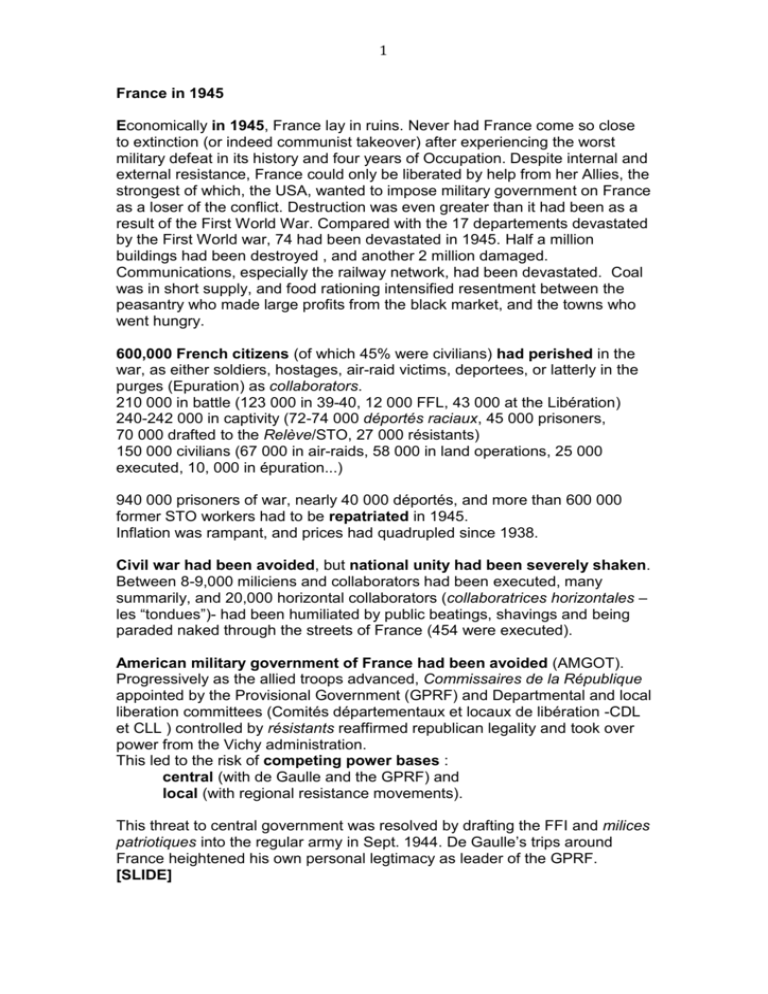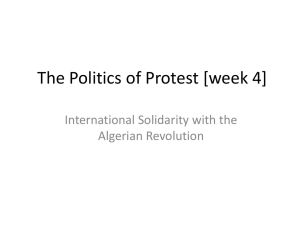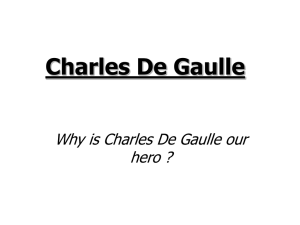View/Open
advertisement

1 France in 1945 Economically in 1945, France lay in ruins. Never had France come so close to extinction (or indeed communist takeover) after experiencing the worst military defeat in its history and four years of Occupation. Despite internal and external resistance, France could only be liberated by help from her Allies, the strongest of which, the USA, wanted to impose military government on France as a loser of the conflict. Destruction was even greater than it had been as a result of the First World War. Compared with the 17 departements devastated by the First World war, 74 had been devastated in 1945. Half a million buildings had been destroyed , and another 2 million damaged. Communications, especially the railway network, had been devastated. Coal was in short supply, and food rationing intensified resentment between the peasantry who made large profits from the black market, and the towns who went hungry. 600,000 French citizens (of which 45% were civilians) had perished in the war, as either soldiers, hostages, air-raid victims, deportees, or latterly in the purges (Epuration) as collaborators. 210 000 in battle (123 000 in 39-40, 12 000 FFL, 43 000 at the Libération) 240-242 000 in captivity (72-74 000 déportés raciaux, 45 000 prisoners, 70 000 drafted to the Relève/STO, 27 000 résistants) 150 000 civilians (67 000 in air-raids, 58 000 in land operations, 25 000 executed, 10, 000 in épuration...) 940 000 prisoners of war, nearly 40 000 déportés, and more than 600 000 former STO workers had to be repatriated in 1945. Inflation was rampant, and prices had quadrupled since 1938. Civil war had been avoided, but national unity had been severely shaken. Between 8-9,000 miliciens and collaborators had been executed, many summarily, and 20,000 horizontal collaborators (collaboratrices horizontales – les “tondues”)- had been humiliated by public beatings, shavings and being paraded naked through the streets of France (454 were executed). American military government of France had been avoided (AMGOT). Progressively as the allied troops advanced, Commissaires de la République appointed by the Provisional Government (GPRF) and Departmental and local liberation committees (Comités départementaux et locaux de libération -CDL et CLL ) controlled by résistants reaffirmed republican legality and took over power from the Vichy administration. This led to the risk of competing power bases : central (with de Gaulle and the GPRF) and local (with regional resistance movements). This threat to central government was resolved by drafting the FFI and milices patriotiques into the regular army in Sept. 1944. De Gaulle’s trips around France heightened his own personal legtimacy as leader of the GPRF. [SLIDE] 2 History and memory in post-war France Above and beyond those who had actively resisted or collaborated, every social and economic group had been affected morally or physically by the war and Occupation, and had their own personal, individual memory, recollection of events, that did not necessarily coincide with the collective memory formulated after the Liberation. After the First World War, up and down the country, in cities, towns and villages all over France, war memorials sprang up to commemorate French losses - the million and a half dead on the so-called champs d'honneur. This common focus for mourning facilitated the process. However, the nature of the deaths in WW2 were more varied and complex, and led to what Henry Rousso has labeled, a process of “Unfinished Mourning” whereby for many, those conflicts remain unfinished business, with many French people unreconciled to their own history during the Occupation. As the title of another one of his books suggests, it is indeed un passé qui ne passe pas, “an ever-present past” Vichy, un passé qui ne passe pas, with Éric Conan, Paris, Fayard, 1994, 327p. Shortages of food and supplies had been a daily reality for the vast majority of French people Petites et grandes lâchetés – in order to survive, many had done things they would have preferred not to Others had lived the war separated from a loved one (prisoner in Germany, Obligatory Labour Draft, STO from early 1943) In the case of Alsace-Lorraine, forced drafting into the German Army took place from August 1942. Of the 130,000 malgré-nous as they were called “the unwilling” (and indeed the 15,000 « Malgré-elles »), some 32,000 were killed in action and 10,500 are still missing in action, and presumed dead. (Regional collective Memory in Alsace is in itself a a fascinating case study : Cf In Aug 1914, 18,000 men from the Alsace-Lorraine region served in the French Army, and 380,000 were conscripted into the German Army. Cf also trial of 14 Alsatians for the massacre of Oradour-sur-Glane in 1953. They felt betrayed by the FFI, the Free French, de Gaulle, the Americans, who treated them like German POWs after desertion, and the Soviets as war criminals and imprisoned in Goulags (16,000 died in Goulags or Yugoslavian prisons the 4th Republic) 3 Many had suffered the loss of a family member (father, son, brother etc) in the fighting In 1940 Between 1940-43 in Africa and the Levant During the Liberation from 1944-45 or indeed in German uniform, or in the service of the Vichy Regime. Many were executed as collaborators during the Epuration, the Purges that followed the Germany retreat. Others had also lost members through -German repression -air-raids, -at the Liberation, or through -deportation (there were 141 000 déportés, 10% women). There was a clear distinction made between different types of deportees, i.e., those deported for political and those deported for religious reasons. The déportés politiques numbered 66 000 (46 000 for resistance, 23 000 survivors – 34% survival rate). As early as 1943, the GPRF gave this group a special status of déportés politiques which gave a pension, health benefits and allowances, early retirement and a medal. The déportés raciaux (religious persecution) numbered 76 000, + 4 000 in internment in France. They amounted to 54 % of the total deported. Only 2 500 survived, which is only a 6 % survival rate). The Jewish community prefered not to promote their suffering to help the reintegration of survivors – however, from the 1960s onwards, the memory of genocide was rekindled by -the the Eichmann trial in May 1961, followed by -the 6 day war in June of the same year -the showing of the film Holocaust in 1978-79, then the -trials of Barbie in 1980s and of Touvier 1994, (Bosquet shot in 1993), and -Papon in 1998. Some of these events could have fed collective memory, but not all of them did. In a word, the memory of the resistance was abundantly present in collective memory, whereas the suffering of the Jewish community in France was not addressed, and swept under the carpet – l’oubli. This selective version of history has often been the result of a policy of concealment. [SLIDE] 4 From the outset, a clear hierarchy emerged with the formulation of official, collective memory, sanctioned by a legal framework (for the political déportés politiques) that led to group memory often being neglected (for example, it wasn’t until 1993 that a commemorative day was introduced “to pay homage to the victims of racist and antisemitic persecutions perpetrated by the French State” (“en hommage aux victimes des persécutions racistes et antisémites de l’Etat français”). This is in stark contrast with memorialization of the resistance; 1954 = a day to celebrate deportees was proclaimed, 1946 = the 8 May was designated as VE day 1953 = VE day designated as public holiday A tension thus emerged between the desire to celebrate glorious or heroic actions (of the resistance) and to forget the shameful (of the collaborators). The memory and consequent memorialization of Nazi atrocities centered on crimes committed against the French. Up until the mid 1970s, Nazi Barbarity was best illustrated by the Mont Valérian fortress, scene of the execution of more than 1000 résistants, or Oradour-sur-Glane, the village martyr where 642 innocent men women and children were massacred by the SS Das Reich division (including at least 14 Alsatians), and Tulle (213 victims, of whom 99 were hanged from trees, lampposts and balconies). Significantly, Oradour-sur-Glane was visited by De Gaulle in 1945 who ordered that it be preserved for posterity as a memorial to Nazi aggression. Conversely, the Vel’ d’Hiv (13 500) was demolished, and we would have to wait until Barbie’s trial in 1985 to learn of the deportation of 44 children and 7 adults from the Orphanage at Izieu. Perspective- In 1942: 42 000 deported, and only 811 returned after war. This creation of selective, collective memory was officially sanctioned i.e. the construction of a mausoleum on the Mont Valérian fortress site from 1946, then a Mémorial de la France combattante when de Gaulle returned to power in 1960. A ceremony takes place every 18 June. The representation of the horror of the Nazi concentration camps centered on Buchenwald where resisters and political deportees were held, and not Auschwitz-Birkenau where Jews and gypsies formed the bulk of the detainees (a much more powerful Lieu de mémoire - sites of memory) not Auschwitz extermination camp. Mitterrand’s personal history during Vichy and his relationship with other figures from the period (Bousquet, Papon) prevented many from being brought to trial before his death in 1995. This explains why many high-ranking officials were tried 40 years after the events 5 -Barbie (1985) -Touvier (high-profile milicien, 1994) -Bosquet (head of Vichy police shot in 1993) and -Papon (1998) [SLIDE] The influence of De Gaulle as the Provisional govt prime minister until 1946, and president from 1958 to 1969, anchored the myth of resistancialism, and formalised what was to become known as the Gaullist myth. The `Gaullist myth' can be summarised in a number of central tenets or beliefs: there was minimal collaboration - only a handful of crackpots and marginals who were atypical of French opinion; national unity - the French were essentially unified, essentially patriotic (with only a few misguided individuals); France's interests were protected by an élite of heroic Resistance fighters (supported by the mass); Charles de Gaulle was the personification of the Resistance - `le premier Résistant de France'. Of course, this resistance was real : equivalent to 18 divisions (480,000 soldiers) by the end of 1944, but so was collaboration (cf “Collaboration in wartime France, 1940–1944”, Fabian Lemmes, European Review of History: Revue europeenne d'histoire, 1469-8293, Volume 15, Issue 2, 2008, Pages 157 – 177. In addition, this resistancialism was at the expense of the need to remember the sacrifice of other groups that had suffered during the war, notably racial deportees. **************** As prime minister in the French Provisional Government until 1946, and later President of the 5th Republic from 1958-69, de Gaulle used every occasion to reinforce and assert this official collective memory, starting with 25 Aug. 1944 at the Liberation of Paris : “Paris ! Paris outragé ! Paris brisé ! Paris martyrisé ! mais Paris libéré ! libéré par lui-même, libéré par son peuple avec le concours des armées de la France, avec l'appui et le concours de la France tout entière, de la France qui se bat, de la seule France, de la vraie France, de la France éternelle.” 6 Paris! Paris outraged! Paris broken! Paris martyred! But Paris liberated! Liberated by itself, liberated by its people with the help of the French armies, with the support and the help of all France, of the France that fights, of the only France, of the real France, of the eternal France! [SLIDE] Vichy’s State collaboration was glossed over, and the political class projected in public opinion an image of France which had massively resisted nazism (20,000 resistors killed in combat). More succinctly, at Petain’s trial, Chief Prosecutor Mornet spoke of the period of the Occupation as being “four years to erase from French History”. In a later speech on the 31 December 1944 de Gaulle repeated this view: “Sauf un nombre infime de malheureux qui ont consciemment préféré le triomphe de l'ennemi à la victoire de la France et qu'il appartient à la Justice de l'État de châtier équitablement, la masse immense des Français n'a jamais voulu autre chose que le bien de la patrie, lors même que beaucoup furent égarés sur le chemin. “ “With the exception of a tiny number of wretched individuals who consciously preferred the triumph of the enemy to the victory of France, that the Justice system will punish fairly, the immense majority of the French never wanted anything else but the good of the country, even if some got lost along the way. “ These speeches are essential to our understanding of the so-called `Gaullist myth' that emerged after the Liberation. A number of posters also clearly illustrate this gaullist distortion of reality. [SLIDE] De Gaulle’s exclusion from the conferences of Teheran, Yalta and the planning of Overlord, contrast starkly with this image of de Gaulle at the head of a victorious superpower. [SLIDE] Historians and critics have proposed a number of explanations for the `Gaullist Myth': to boost morale; to establish order/stability; to reinforce de Gaulle's political legitimacy; to assert France's claim to greatness (rentrer dans le rang). 7 In 1969, explaining his opposition to Le Chagrin et la Pitié, de Gaulle stated: On fait l’Histoire avec une ambition, pas avec des vérités. De toute manière, je veux donner aux Français des rêves qui les élevent plutôt que des vérités qui les abaissent” History is made with ambition, not truth. In any case, I want to give the French dreams that raise them up rather than truths that demean them. Why did this collective amnesia suddenly prevail in 1944? France was under threat of Amgot, and was treated as a loser by the US and the USSR (de Gaulle was not informed of invasion plans in 1942 or 44, or asked to Yalta or Potsdam). National consensus needed these events to be forgotten, as the very survival of France was at risk. This amnesia lead to a repression of the past (refoulement du passé, “un passé qui ne passe pas”) for over 50 years. [SLIDE] There was even the coexistence of 2 resistance myths, the gaullist and the communist until 1947 (when communist ministers sacked from government). = Résistancialisme (Though de Gaulle has the moral high-ground as he was the lone voice on 18 June to call for resistance – cf PCF 21 June 1941). Le "Appels", celui du 17 juin 1940 de Pétain : "Je vous dis qu'il faut aujourd'hui cesser le combat", suivi par celui du Général, le 18 juin : "La défaite est-elle définitive ? Non !") At the Liberation, the PCF capitalised on the decisive contribution of the USSR in the defeat of nazism to proclaim itself le parti des 75 000 fusillés (the Party of the 75,000 executed) whereas the total number of executions does not exceed 30,000 (including non-communists), and according to more recent research, the figure is 5200. (Jean-Pierre Besse, Les fusillés : Répression et exécutions pendant l'Occupation (1940-1944), Editions de l'Atelier 2006). Cf Posters Individuals such as Gabriel Péri, Colonel Fabien, Jacques Decour, Manouchian, les fusillés (martyrs) of Châteaubriant Jean-Pierre Timbaud, Guy Moquet were recuperated by the PCF. In the elections of 1946, the PCF obtained 29% of the vote (in 2007 presidential elections 1.93% of the vote, 2007 legislative elections in June, first round 4.29 [same as FN], second round 2.28%). The party's strong electoral showing and surge in membership led some observers, including the Americans, to believe that a Communist takeover of France was imminent. 8 When the PCF left government in 1947, a parallel myth of Résistancialisme developed. The gaullist right accused the communists of excessive epuration (reglements de compte) during 1944-45. Accusations of 100,000 victims (in reality 10,000) in a bolshevic style coup d'État to introduce a socialist state in France. In return, the PCF minimised the role of La France Libre in the Liberation, and emphasised the clandestine role of the PCF and its role as a martyr party. It also simplified reality, by emphasising what it saw as the class-based nature of the resistance : the poor resisted, the rich collaborated [SLIDE] However, despite this myth of Résistancialisme, in reality, it became clear that the Occupation was arguably a French civil war between la Milice, collaborationists and different groups of the resistance. Independently of Nazi repression, Vichy had its own policy of exclusion, repression and persecution: against communists, foreigners, freemasons, Jews and the resistance. Collaboration had been ideologically motivated and structured and not the work of a few misguided traitors. The Vichy regime was the first time in French History that the extreme right had come to power. Men from both the right and the left participated enthusiastically in Petain’s National Revolution, this moral revolution inspired by the ideas of the traditional French Right, and which was determined to proceed to a regime change. That Vichy and many Frenchmen had collaborated was beyond doubt. According to recent research probably 250,000 French people were collaborationist. Researchers analysing the sales figures of the collaborationist weekly press, have estimated that the circle of sympathisers was much broader, as much as one or two million. There are a number of areas in which collaboration/collaborationism to place: Economic The form was either for profit, by political-ideological identification or for survival -The French State had provided 1/3 of the German War effort by 1942, and in the last two years of the occupation, French industry became an indispensable part of the German war economy - In 1943, France provided 40% of the war material that was produced in the occupied territories on German orders, but also important food and clothing supplies as well as consumer goods. -15,000 workers voluntarily went to work in German factories, and 650 000 were drafted, under Vichy legislation by the STO to work in Germany. -Renault was nationalised after the war. Photomaton offered services to photograph Jews in camps 9 Ideological and racial -The antisemitic statut des juifs had not been imposed by the Germans, and was seen by Petain as a necessary measure to restore France (cf recent resurfacing of minutes friom cabinet meeting on Statut annotated and made more severe by Petain) -Vichy was directly responsible for the deaths of 76,000 Jews deported by the regime, and was an active cog in the extermination process of the Germans Collaboration de plume/artistique Military/Police -Frenchmen in the Milice had killed and tortured other Frenchmen, others had donned German uniform to fight for Hitler (LVF 6 500, SS Charlemagne [Hitler’s bunker] 7 400, in total 40 000 for all branches of the German military, cf the same as for France Libre before 1942). This bout of Collective amnesia continued until the death of de Gaulle. French collaboration with Nazi Germany and the nature of the Vichy regime were not widely studied until the 1970s. Some notable exceptions include Raymond Aron’s very influential and very indulgent Histoire de Vichy (Paris: Fayard, 1954) Significantly, major contributions came from abroad in the late 1960s, and early 1970s, namely by Stanley Hoffmann, Eberhard Jackel and Robert Paxton. Hoffmann, Stanley. “Collaborationism in France during World War II.” Journal of Modern History (1968): 375–95. Jackel, Eberhard. Frankreich in Hitlers Europa. Stuttgart: 1966 Paxton, Robert O. Vichy France: Old Guard and New Order, 1940–1944. New York: 1972, The publication in 1972 by Robert Paxton of Vichy France Old Guard and New Order revealed the full extent of French collaboration during the Occupation. This book brought about caused a crucial paradigm shift. The translation of this book into French the following year opened the floodgates of history and historiography on the subject in France. Important research activity on Vichy and the Occupation remains unbroken up until today. JeanPierre Azema, PascalOry, Henry Rousso and Philippe Burrin stand out. [SLIDE] Henry Rousso provides a very useful explanation of the dynamics of memorialisation during this period: Collective memory went through four distinct chronological stages defined by the specifics of the political priorities and developments of each respective period: 1. 1944-1954: Unfinished Mourning = the years of the Gaullist 5th Republic which sought to silence any reminder of past divisions, and construct the Gaullist myth 2. 1954-1971: Repressed Memory 10 = imperfect coming-to-terms with the past that ignored, for example, the antisemitism of Vichy and its complicity in the deportation of 76,000 Jews 3. 1972-1980: The Broken Mirror The period from 1972 until 1980 sees the return of repressed memory. What had been smothered under a reassuring myth of national resistance returned, and returned with unexpected vehemence. A number of developments after 1968 unsettled the image many French people had of the period of Occupation. Amongst the most important developments were the release of Marcel Ophüls' Le Chagrin et la pitié in 1969 that showed the experience of one town, Clermont Ferrand during the occupation. and Louis Malle's Lacombe Lucien in 1973 which showed the random nature of political choice. 1973: the French translation of Robert Paxton's Vichy France: Old Guard and New Order 1940-1944 (La France de Vichy) in 1972. These all played, in their different ways, an important role in ushering in a new period in France's troubled relation to its wartime past, the period Rousso calls that of le miroir brisé. 4. 1980-present: Obsession By 1980 and the beginning of the Mitterrand years, the repression and reassessment of les années noires had turned into an obsession. Every month a new revelation about the period of Occupation would appear and dominate the news agenda. The trials of Klaus Barbie (1987), of Paul Touvier (1994), Maurice Papon (1997-8) and, more recently still, the attempted extradition of Aloïs Brunner from Syria to face a trial for crimes against humanity in France (1999) have also served to give the Occupation a continued high media profile. [SLIDE] Chirac was the first post-war president to break with the Gaullist consensus in 1995 when he spoke in July 1995, 53 years after the Rafle du Vel’ d’Hiv’, of “ces heures noires [qui] souillent à jamais notre histoire, et [qui] sont une injure à notre passé et à nos traditions. Oui, la folie criminelle de l’occupant a été secondée par des Français, par l’Etat français. Il y a cinquante-trois ans, le 16 juillet 1942, 4 500 policiers et gendarmes français, sous l'autorité de leurs chefs, répondaient aux exigences des nazis. Ce jour-là, dans la capitale et en région parisienne, près de dix mille hommes, femmes et enfants juifs furent arrêtés à leur domicile, au petit matin, et rassemblés dans les commissariats de police. (…) La France, patrie des Lumières et des Droits de l'Homme, terre d'accueil et d'asile, la France, ce jour-là, accomplissait l'irréparable. Manquant à sa parole, elle livrait ses protégés à leurs bourreaux. “ 11 These black hours will stain our history for ever and are an insult to our past and our traditions. Yes, the criminal madness of the occupant was abetted by the French, by the French state. Fifty-three years ago, on 16 July 1942, 450 French policemen and gendarmes, under the authority of their leaders, obeyed the demands of the Nazis. That day, in the capital and the Paris region, nearly 10,000 Jewish men, women and children were arrested at home, in the early hours of the morning, and assembled at police stations. [...] France, home of the Enlightenment and the Declaration of the Rights of Man and of the Citizen, land of welcome and asylum, France committed that day the irreparable. Breaking its word, it delivered those it protected to their executioners." Mitterrand’s personal history during Vichy and his relationship with other figures from the period (Bousquet, Papon) had prevented many from being brought to trial before his death in 1995. Chirac was the first president of the Fourth and Fifth Republic to have the courage to refute the Gaullist myth. ********************** [SLIDE] Algeria and Collective memory Coming to terms with Vichy and the Occupation is frequently cited as a model for dealing with the French Colonial history of Algeria. Similar dynamics of memory and collective amnesia, or at least selective memorialisation, arose with Algeria 10-15 years later. (As we will see, the Algerian “War” was only acknowledged in 1999, as was systematic use of torture). Like the Occupation, the Algerian War was a historical trauma, an agonising mass experience creating (cf Benjamin Stora) a collective neurosis or syndrome, so remembrance can be likened to a collective therapy. But clearly, as we have seen with the case of the Occupation, there is not one single narrative of memory, or one single national psyche. Indeed, there is not one “Algerian War” it was polymorphic, it was several wars, at least 4 -a French-Algerian War FLN vs French Army -a French Civil War French State vs OAS -porteurs de valises ("the suitcase carriers" Jeanson network of PCF militants sympathisers of FLN) vs government within France -an Algerian civil war Harkis vs FLN So memory of the Algerian War is also clearly fragmented. 12 We find from the outset (directly after Evian agreements in March 1962) the same policy of concealment as with the memorialisation of the Occupation. The French State attempted to conceal the excesses of the colonial past of France in Algeria. This led to a discrepancy between the official version and public debate. Events such as -Setif in May 1945 (beginning of Algerian War for Independence?) -The events of 17 October 1961 -Rue de Charonne 8 February 1962 -Massacre of la rue d’Isly 26 March 1962 -Abandoning of the Harkis (Algerians fighting within the French Army) -The systematic use of torture, and often murder by the French Army were not officially acknowledged in official discourse, especially not by French Presidents. Parallel to this state-sponsored concealment, there was a constant pressure to remember felt by the historical actors, or non-state “memory lobbies”, that cultivated a group identitiy and kept alive and diffused this memory of the War. The historical actors were -the almost one million French of Algeria (pieds-noirs), who cultivated a group identity within families and communities) -the two million war veterans -the harkis. They did not join the debate as actors until the late 1990s (Harkis day in 2001). Rejected by both sides. The veterans challenged the policy of concealment. They were denied an official status as war veterans, as the Algerian War was not considered a war until 1999, despite the event clearly being the 3rd violent conflict in the 20th Century. So they were denied the status and material benefits of war veterans. [SLIDE] The French State used two main tools to prevent a remembrance of the conflict: -control of official language on the event, and censorship, and -general amnesty law for crimes committed closed the door on a judicial aftermath (22 March 1962). A second amnesty was enacted in 1968 by the National Assembly, which gave blanket amnesty to all acts committed during the Algerian war. A futher general amnesty for all war crimes was declared in 1982. The word “War” was not used until the end of the 1990s. On 10 June 1999, the national Assembly unanimously replaced euphemisms such as “peacekeeping operations”, “events” (événements) with “La guerre 13 d’Algerie”. It would take almost 40 years for official language to be adjusted to public discourse. ****************** Attention then turned to the abandonning of the Harkis (Muslim Algerian auxillaries in the French Army) after the Accords d’Evian was also swept under the carpet of History. At least 30,000 and possibly as many as 150,000 Harkis and their dependents were massacred -sometimes in circumstances of extreme cruelty- after the withdrawal of the French. Alistair Horne writes in A Savage War Of Peace: "Hundreds died when put to work clearing the minefields along the Morice Line, or were shot out of hand. Others were tortured atrociously; army veterans were made to dig their own tombs, then swallow their decorations before being killed; they were burned alive, or castrated, or dragged behind trucks, or cut to pieces and their flesh fed to dogs. Many were put to death with their entire families, including young children." Those who had managed to leave were housed for decades by the French governments in appaling conditions, often in camps previously used for interning Jews during the Occupation. On 25 September 2001, President Chirac proclaimed a National Day of Homage to Harkis, and recognised the contribution of the Harkis. No mention, however, was made of the failure of the Gaullist government to prevent massacres, and certainly no apology was forthcoming. Rachid Bouchareb’s 2006 film, Indigènes, was the final step towards public recognition of the role of indigenous Algerian troops in the Second World War, and implicitly by association, that of the Harkis. [SLIDE] The use of torture, exonerated by the amnesty laws, did not come to the surface of public debate until several decades later, despite this memory being debated and researched openly since François Mauriac in 1954 in an article titled “Surtout, ne pas torturer” in the Express, and the publication of La Question by Henri Alleg in 1958. According to historian R. Branche, torture would begin with the systematic stripping of the victim. Beating was combined with many different techniques, among them hanging by the feet or hands, water torture, torture by electric shock, rape. For many, France, “le pays des droits de l’homme” was behaving as the Germans had done in France 15 years previously – torture, arbitrary arrest, murder, violence. 14 This reality was never officially acknowledged until almost 40 years after the end of the war. Up to a million Algerians could have been killed, 25,600 French dead, 65,000 wounded. On 20th June 2000, an article on the front page of le Monde caused an earthquake that initiated unprecedented debate and outcry in France over the treatment of Louisette Ighilariz. At the age of twenty she had been captured in September 1957, during the Battle of Algiers, and had been raped and tortured for three months. Unusually, Ighilariz’s approach was not to call for vengeance and justice as much as it was to thank a French military doctor that saved her. She accused high ranking French Army commanders, notably General Massu of ordering, attending and participating in interrogations. Massu, the first of many interviews with veterans over the following months, acknowledged that torture had taken place, and even questioned its efficiency as a practice. The bombshell came with an interview on 23 November 2000 in Le Monde with General Aussaresses. Without emotion or regret he admitted to acts of torture and summary executions. He added that he would do it again is necessary, and saw no need for repentance. Following Aussaresses' revelations, which indicated that torture had been ordered by the highest levels of the French state hierarchy, Human Rights Watch sent a letter to President Jacques Chirac to indict Aussaresses for war crimes, declaring that, despite past amnesties, such crimes, which may also have been crimes against humanity, may not be amnestied. His book Services Spéciaux, Algérie 1955-1957, published in May 2001 sold 100,000 copies, but landed him in court for apology of war crimes, put him on the retired list, and stripped him of his Legion d’Honneur. Both President Chirac and Prime Minister Jospin reacted cautiously to media enquiries and public pressure, suggesting that a reassessment of the Algerian War should be done by historians, not legislators or ministers. Neither accepted to recognize and condemn the practice of torture. By mid 2002, the debate had begun to recede, yet it was clear that official recognition or memorialization of the conflict would not integrate the issue of torture. [SLIDE] Clearly the French Army repression in Algeria had been savage, and the government at the time was complicit. Above and beyond the question of torture, official commemoration was also very selective in what it recorded for the period of the Algerian War, and even before. What is significant is that a number of major events were all but forgotten in collective memory (examples of government censure?): 15 Sétif 8 May 1945, riots led to death of 27 Europeans (103 in the following days). French authorities restored order but then carried out a series of reprisals. The army, which included Foreign Legion and Senegalese troops, carried out summary executions. Less accessible Muslim villages were bombed by French aircraft, and a cruiser off the coast in the Gulf of Bougie, shelled Kerrata. These reprisals killed anywhere between 1,020 (the official French figure given in the Tubert Report shortly after the massacre) and 45,000 people (radio Cairo). The Sétif outbreak and the repression that followed marked a turning point in the relations between France and the Muslim population of Algeria. The most explicit comments by the French state on the massacre were only made in February 2005, by Hubert Colin de Verdière, France's ambassador to Algeria. He formally apologized for the massacre, calling it an “inexcusable tragedy”. The Madagascar Revolt 1947 and 1948 was a rebellion against the colonial rule of France by nationalists on the island of Madagascar in. It was crushed by the French government. 80,000 to 90,000 people were killed, according to certain sources. More recently, however, historians have suggested the much lower figure of 30,000 to 40,000. During an official visit to Madagascar on 21 July 2005, French President Jacques Chirac qualified as "unacceptable" the repression of the Malagasy uprising. The events of 17 October 1961 The Parisian Police under Maurice Papon, convicted in 1998 on charges of crimes against humanity for his role during Vichy, repressed a demonstration of about 25,000 Algerians against a curfew organized by the FLN. Many demonstrators died when they were violently herded by police into the River Seine, with some thrown from bridges after being beaten unconscious. Other demonstrators were killed within the courtyard of the Paris police headquarters after being arrested and brought there in police buses. Officers who participated in the courtyard killings took the precaution of removing identification numbers from their uniforms. More than 11,000 people were arrested and between 70 and over 200 people were killed. The massacre was directed by Maurice Papon. After 37 years of denial, the French government finally acknowledged 40 deaths in 1998. Rue de Charonne 8 February 1962 demonstration in Paris to denounce the OAS and the Algerian war led to 9 deaths at the Charonne metro station. Massacre of la rue d’Isly 26 March 1962 : a crowd of unarmed French civilians, including women and young adolescents, demonstrating against the independence of Algeria was machine-gunned after breaking through an army checkpoint in Algiers. This checkpoint had been set up to search a district after the murder of six drafted French soldiers by the OAS. Between 62 to 80 civilians were killed in the space of 15 minutes, and 7 soldiers (including 2 gendarmes), and 200 were wounded. 16 Immediately after the events, European settlers accused the FLN of being agent provocateurs, and murdered 10 Algerians in reprisals. It is the last example of civil war between Frenchmen, and the most blatant example of censorship during the Algerian War in France. Again, as with the case of the Occupation, this past of torture, violence and barbarity would not be confronted until long afterwards (1999) The State’s attempt to establish official memory have often been at best hotly contested, at worst clumsy, chaotic and contradictory. [SLIDE] Shortly after the debates on torture had subsided, the law of 23 February 2005 reignited passions. Symbolic acts of rapprochement undertaken by Chirac in Algeria from 2003 led to a political backlash in France. One example of this was Article 4 of the 2005 law, which specified that school programmes should underline the positive role of colonialisation and the contribution of the harkis. This law was voted without any resistance or debate from the Communist or socialist opposition. Public outcry afterwards stimulated political debate and conflict, notably between the future president Nicolas Sarkozy and Dominique de Villepin. On the 7 Dec 2005, Nicolas Sarkozy insisted that « qu'il faut cesser avec la repentance permanente [qui consiste à] revisiter notre histoire. Cette repentance permanente, qui fait qu'il faudrait s'excuser de l'histoire de France, parfois touche aux confins du ridicule » A day later, Dominique de Villepin claimed that « ce n'est pas aux politiques, ce n'est pas au Parlement d'écrire l'Histoire ou de dire la mémoire. C'est la règle à laquelle nous devons être fidèles. (…) Il n'y a pas d'histoire officielle en France » Faced with such opposition, and unable to undo the law through parliament, President Chirac went before the Conseil Constitutionnel to seek advice on how to remove reference to the “role positif”, and was able to do so by governmental decree. The outcry over the 23 February 2005 law shows that the official memory of the Algerian War and colonialism in France has been created by many varied and antagonistic sources, and often the role of the president is fundamental. This is made clear by two failed attempts in 2007 by Nicolas Sarkozy to influence memorialization of the Occupation -on the resistance, by making the reading in schools of Guy Moquet’s final letter a compulsory part of the curriculum. 17 -on the Shoah, by announcing that he wanted each 10-year-old pupil to study the life and death of one of France’s 11,000 child Holocaust victims. The idea of making teachers read the letter, and studying child Holocaust victims ran into criticism from politicians and teachers who said it might be psychologically too much for 10-year-olds to bear. Conclusion: Since the end of the Second World War, personal, individual memory, did not coincide with the collective memory formulated after the Liberation by de Gaulle. In the examples of both the Occupation and the Algerian War, we see that the French State formulated a selective history of events, mostly based on a policy of concealment. In the case of the Occupation, the State concealed the full extent of State Collaboration and its responsibility in the Shoah, with official memorialisation of the Resistance. This memorialisation would not be challenged until the beginning of the 1970s, and after scholarship from abroad (Paxton). In the case of Algeria, non-state memory lobbies and historical actors, such as the pieds-noirs and war veterans, challenged policy of concealment. The State controlled the official language on the War, and preempted justice for those tortured or killed by voting amnesty laws, and censored unsavoury truths. Like memorialisation of the Occupation, it took nearly 40 years for official language to be adjusted to public discourse.







